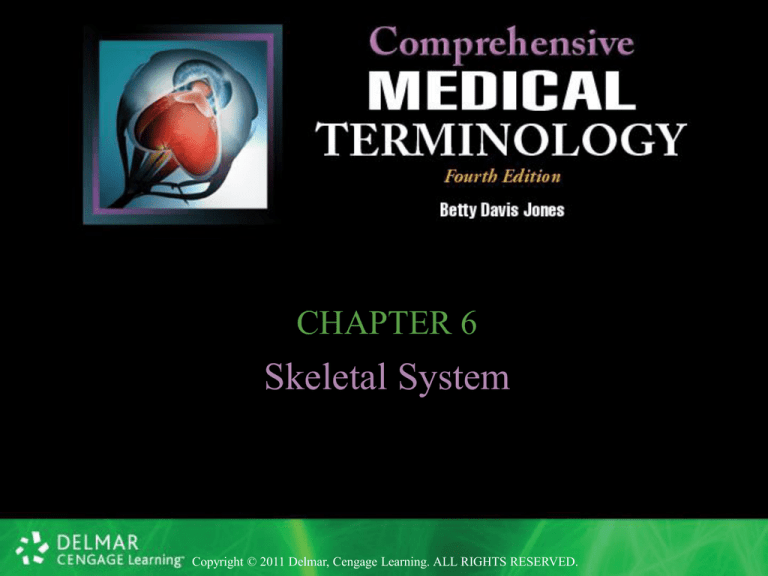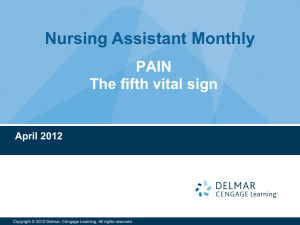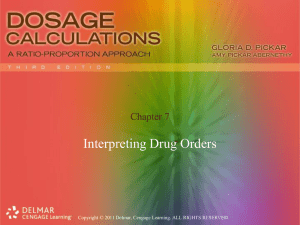
CHAPTER 6
Skeletal System
Copyright © 2011 Delmar, Cengage Learning. ALL RIGHTS RESERVED.
Skeletal System
• Human skeleton consists of 206 bones
–
–
–
–
–
Serves as supporting framework of body
Protects vital internal organs
Important role in movement = attachments for muscles
Reservoir for storing minerals
Red bone marrow = blood cell formation
Copyright © 2011 Delmar, Cengage Learning. ALL RIGHTS RESERVED.
Bone Structure
• Diaphysis
– Main shaft-like portion of a long bone
– Compact bone
• Epiphysis
– Located at each end of a long bone
• Epiphyseal line
– Separates diaphysis from epiphysis
Copyright © 2011 Delmar, Cengage Learning. ALL RIGHTS RESERVED.
Bone Structure
• Periosteum
– Covers the surface of the long bone
• Articular cartilage
– Covers joint surfaces
Copyright © 2011 Delmar, Cengage Learning. ALL RIGHTS RESERVED.
Bone Structure
• Medullary (marrow) cavity
– Contains yellow marrow
• Spongy bone (trabeculae)
– Also called cancellous bone
Copyright © 2011 Delmar, Cengage Learning. ALL RIGHTS RESERVED.
Bone Structure
• Red bone marrow
– Site for blood cell production
• Yellow marrow
– Stores fat
Copyright © 2011 Delmar, Cengage Learning. ALL RIGHTS RESERVED.
Bone Structure
Copyright © 2011 Delmar, Cengage Learning. ALL RIGHTS RESERVED.
Question
The bony skeleton serves many purposes
EXCEPT:
a.
b.
c.
d.
structure
movement
digestion
red cell production
Copyright © 2011 Delmar, Cengage Learning. ALL RIGHTS RESERVED.
Question
True or False: To keep epiphysis and diaphysis
straight, remember that epi- means outermost
and dia- means through.
Copyright © 2011 Delmar, Cengage Learning. ALL RIGHTS RESERVED.
Bone Markings
• Bone markings = specific features of bones
–
–
–
–
–
–
Enlargements that extend out from the bone
Openings within the bone
Hollow regions within the bone
Points of attachment for muscles and tendons
Points for joining one bone to another
Cavities and passages for nerves and blood vessels
Copyright © 2011 Delmar, Cengage Learning. ALL RIGHTS RESERVED.
Bone Depressions
• Concave areas or openings in a bone
– Help form joints
– Serve as points of attachment for muscle
• Sulcus
– Groove or depression in a bone
• Example = fissure
Copyright © 2011 Delmar, Cengage Learning. ALL RIGHTS RESERVED.
Bone Depressions
• Sinus
– Opening or hollow space in a bone
• Example = frontal sinus
• Fossa
– Hollow or shallow concave depression in bone
• Example = fossa of the iliac (hip) bone
Copyright © 2011 Delmar, Cengage Learning. ALL RIGHTS RESERVED.
Bone Depressions
• Foramen
– Hole within a bone for blood vessels or nerves to pass
through
• Example = foramen magnum of the skull
Copyright © 2011 Delmar, Cengage Learning. ALL RIGHTS RESERVED.
Question
What do you think passes through the foramen
magnum ("great hole") on the underside of
the skull?
a.
b.
c.
d.
neck muscles
spinal cavity
ball-and-socket joint
aorta
Copyright © 2011 Delmar, Cengage Learning. ALL RIGHTS RESERVED.
Cranial Bones
• Cranium = bony skull
– Envelops brain
– Composed of eight bones
• Immovable bones
– Borders meet to form immovable joints
• Immovable joints = sutures
Copyright © 2011 Delmar, Cengage Learning. ALL RIGHTS RESERVED.
Cranial Bones
Copyright © 2011 Delmar, Cengage Learning. ALL RIGHTS RESERVED.
Facial Bones
• Two bones provide distinctive shape to face
– Maxillae (upper jaw bones)
– Mandible (lower jaw bone)
• All facial bones connected by immovable
joints (sutures)
– One exception (mandible)
Copyright © 2011 Delmar, Cengage Learning. ALL RIGHTS RESERVED.
Facial Bones
Copyright © 2011 Delmar, Cengage Learning. ALL RIGHTS RESERVED.
Question
True or False: The immovable joints in the
skull and face are called fissures.
Copyright © 2011 Delmar, Cengage Learning. ALL RIGHTS RESERVED.
Vertebral Bones
•
•
•
•
Form long axis of the body
Referred to as spinal column or backbone
24 vertebrae + sacrum + coccyx
Offer protection to spinal cord
Copyright © 2011 Delmar, Cengage Learning. ALL RIGHTS RESERVED.
Vertebral Bones
• Cervical vertebrae
– Vertebrae of the neck (cervic/o = neck)
– Identified as C1 - C7
• Thoracic vertebrae
– Vertebrae of the chest (thorac/o = chest)
– Identified as T1 - T12
Copyright © 2011 Delmar, Cengage Learning. ALL RIGHTS RESERVED.
Vertebral Bones
• Lumbar vertebrae
– Vertebrae of lower back (lumb/o = lower back, loins)
– Identified as L1 - L5
Copyright © 2011 Delmar, Cengage Learning. ALL RIGHTS RESERVED.
Vertebral Bones
• Sacrum
– Singular, triangular shaped bone
– Resulted from fusion of five individual sacral bones in
the child
• Coccyx
– Also called “tailbone”
– Resulted from fusion of four individual coccygeal bones
in the child
Copyright © 2011 Delmar, Cengage Learning. ALL RIGHTS RESERVED.
Question
True or False: The first three segments of the
vertebral column are named by their
corresponding body position.
Copyright © 2011 Delmar, Cengage Learning. ALL RIGHTS RESERVED.
Bones of the Thorax
• True ribs (ribs 1-7)
– Attach to sternum in front and vertebrae in back
• False ribs (ribs 8-10)
– Attach to vertebrae in back but attach to cartilage of 7th
rib in front – not the sternum
• Floating ribs (ribs 11-12)
– Attach to vertebrae in back
– Completely free of attachment in front
Copyright © 2011 Delmar, Cengage Learning. ALL RIGHTS RESERVED.
Bones of the Upper Extremities
Copyright © 2011 Delmar, Cengage Learning. ALL RIGHTS RESERVED.
Pelvic Bones
Copyright © 2011 Delmar, Cengage Learning. ALL RIGHTS RESERVED.
Bones of the Lower Extremities
• Femur
– Thigh bone
• Patella
– Knee bone or kneecap
Copyright © 2011 Delmar, Cengage Learning. ALL RIGHTS RESERVED.
Bones of the Lower Extremities
• Tibia
– Larger and stronger of the two lower leg bones
• Fibula
– More slender of the two lower leg bones
Copyright © 2011 Delmar, Cengage Learning. ALL RIGHTS RESERVED.
Bones of the Ankle and Foot
• Ankle bones (tarsals)
– Calcaneus
– Talus bone
• Foot bones
– Metatarsals
– Phalanges
Copyright © 2011 Delmar, Cengage Learning. ALL RIGHTS RESERVED.
Question
The false ribs connect to the cartilage of rib
number ____ instead of the sternum.
a.
b.
c.
d.
7
11
1
9
Copyright © 2011 Delmar, Cengage Learning. ALL RIGHTS RESERVED.
Question
The carpals are to the wrist as the _______ are
to the ankle.
a.
b.
c.
d.
phalanges
tarsals
metatarsals
metacarpals
Copyright © 2011 Delmar, Cengage Learning. ALL RIGHTS RESERVED.
PATHOLOGICAL CONDITIONS
Skeletal System
Copyright © 2011 Delmar, Cengage Learning. ALL RIGHTS RESERVED.
Osteomalacia
• Pronounced
– (oss-tee-oh-mah-LAY-she-ah)
• Defined
– Abnormal softening of the bones due to a deficiency of
calcium and phosphorus in the blood, which are
necessary for bone mineralization
Copyright © 2011 Delmar, Cengage Learning. ALL RIGHTS RESERVED.
Osteomyelitis
• Pronounced
– (oss-tee-oh-my-ell-EYE-tis)
• Defined
– A local or generalized infection of the bone and bone
marrow
– Resulting from a bacterial infection that has spread to the
bone tissue through the blood
Copyright © 2011 Delmar, Cengage Learning. ALL RIGHTS RESERVED.
Osteoporosis
• Pronounced
– (oss-tee-oh-poh-ROW-sis)
• Defined
– Porous bones
– Bones that were once strong become fragile due to loss
of bone density
Copyright © 2011 Delmar, Cengage Learning. ALL RIGHTS RESERVED.
Osteoporosis
Copyright © 2011 Delmar, Cengage Learning. ALL RIGHTS RESERVED.
Question
True or False: Osteoporosis and osteomalacia
are describing the same problem, but one is
more severe than the other.
Copyright © 2011 Delmar, Cengage Learning. ALL RIGHTS RESERVED.
Ewing’s Sarcoma
• Pronounced
– (YOO-wings sar-KOH-mah)
• Defined
– Malignant tumor of the bones common to young adults,
particularly adolescent boys
Copyright © 2011 Delmar, Cengage Learning. ALL RIGHTS RESERVED.
Osteogenic Sarcoma
• Pronounced
– (oss-tee-oh-JEN-ic sar-KOH-mah)
• Defined
– Malignant tumor arising from bone
– Also known as osteosarcoma
Copyright © 2011 Delmar, Cengage Learning. ALL RIGHTS RESERVED.
Osteochondroma
• Pronounced
– (oss-tee-oh-kon-DROH-mah)
• Defined
– Most common benign bone tumor
– Most frequently involves the femur and tibia
Copyright © 2011 Delmar, Cengage Learning. ALL RIGHTS RESERVED.
Paget’s Disease
• Pronounced
– (PAJ-ets dih-ZEEZ)
• Defined
– Nonmetabolic disease of the bone
– Characterized by excessive bone destruction and
unorganized bone formation by the osteoblasts
• Bone is weak and prone to fractures
Copyright © 2011 Delmar, Cengage Learning. ALL RIGHTS RESERVED.
Spinal Stenosis
• Pronounced
– (SPIGH-nal stin-OH-sis)
• Defined
– Narrowing of the vertebral canal, nerve root canals, or
intervertebral foramina
• Openings of the lumbar spinal canal
– Causes pressure on nerve roots prior to their exit from the foramina
Copyright © 2011 Delmar, Cengage Learning. ALL RIGHTS RESERVED.
Talipes Equinovarus
• Pronounced
– (TAL-ih-peez eh-kwine-oh-VAIR-us)
• Defined
– Clubfoot
Copyright © 2011 Delmar, Cengage Learning. ALL RIGHTS RESERVED.
Talipes Equinovarus
Photo courtesy of the Centers for Disease
Control and Prevention
Copyright © 2011 Delmar, Cengage Learning. ALL RIGHTS RESERVED.
Question
If chondr- means cartilage, what do you think
the term osteochondroma literally means?
a.
b.
c.
d.
cartilaginous tumor of the bone
bony tumor of the cartilage
tumor of bone or cartilage
tumor of bone and cartilage
Copyright © 2011 Delmar, Cengage Learning. ALL RIGHTS RESERVED.
Abnormal Curvature of the Spine
• Kyphosis
– Outward curvature = humpback or hunchback
• Lordosis
– Inward curvature = swayback
• Scoliosis
– Lateral (sideward) curvature
Copyright © 2011 Delmar, Cengage Learning. ALL RIGHTS RESERVED.
Abnormal Curvature of the Spine
Copyright © 2011 Delmar, Cengage Learning. ALL RIGHTS RESERVED.
Fracture: Broken Bone
• Closed fracture
– Break in the bone but no open wound in skin
– Simple fracture
• Open fracture
– Break in the bone, as well as an open wound in skin
– Compound fracture
Copyright © 2011 Delmar, Cengage Learning. ALL RIGHTS RESERVED.
Fracture: Broken Bone
• Complete fracture
– Break extends through the entire thickness of bone
• Incomplete fracture
– One side of bone is broken and one side of bone is bent
considerably but not broken
– Greenstick fracture
Copyright © 2011 Delmar, Cengage Learning. ALL RIGHTS RESERVED.
Fracture: Broken Bone
• Compression fracture
– Caused by bone surfaces being forced against each other
• Impacted fracture
– Direct force causes bone to break
– Forces broken end of smaller bone into broken end of
larger bone
Copyright © 2011 Delmar, Cengage Learning. ALL RIGHTS RESERVED.
Fracture: Broken Bone
• Colles’ fracture
– Break occurs at lower end of the radius
– Within 1 inch of connecting with wrist bones
• Hairline fracture
– Minor fracture in which the bone continues to be in
perfect alignment
– Also known as a stress fracture
Copyright © 2011 Delmar, Cengage Learning. ALL RIGHTS RESERVED.
Fracture: Broken Bone
• Pathological fracture
– Bone is weakened by a preexisting disease
– Break is in response to a force that would not cause a
normal bone to break
• Treatment of fractures
– Closed reduction
– Open reduction
Copyright © 2011 Delmar, Cengage Learning. ALL RIGHTS RESERVED.
Question
I jumped down from a ledge and heard a crack
in my shin. X-rays showed that the broken
ends of bone were forced into each other.
This is called a(n) __________ fracture.
a.
b.
c.
d.
greenstick
incomplete
comminuted
impacted
Copyright © 2011 Delmar, Cengage Learning. ALL RIGHTS RESERVED.
Question
True or False: A comminuted fracture can
usually be treated with a closed reduction (no
surgery).
Copyright © 2011 Delmar, Cengage Learning. ALL RIGHTS RESERVED.
DIAGNOSTIC TECHNIQUES, TREATMENTS,
AND PROCEDURES
Skeletal System
Copyright © 2011 Delmar, Cengage Learning. ALL RIGHTS RESERVED.
Diagnostic Techniques, Treatments,
and Procedures
• Bone scan
– Intravenous injection of a radioisotope, which is
absorbed by bone tissue
– Followed by scanning of the skeleton approximately
three hours later to detect areas where the bone absorbs
the isotope
Copyright © 2011 Delmar, Cengage Learning. ALL RIGHTS RESERVED.
Diagnostic Techniques, Treatments,
and Procedures
A
B
(A) anterior view (B) posterior view
Copyright © 2011 Delmar, Cengage Learning. ALL RIGHTS RESERVED.
Diagnostic Techniques, Treatments,
and Procedures
• Bone marrow aspiration
– Removal of a small sample of bone marrow from a
selected site with a needle
– Specimen is examined under a microscope
– Sterile technique
Copyright © 2011 Delmar, Cengage Learning. ALL RIGHTS RESERVED.
Diagnostic Techniques, Treatments,
and Procedures
• Noninvasive procedures for evaluating bone
density
– Dual photon absorptiometry
– Dual energy X-ray absorptiometry (DEXA)
Copyright © 2011 Delmar, Cengage Learning. ALL RIGHTS RESERVED.
Question
True or False: The most common method to
check for osteopenia and/or osteoporosis is
the dual-energy x-ray absorptiometry
(DEXA) scan.
Copyright © 2011 Delmar, Cengage Learning. ALL RIGHTS RESERVED.







